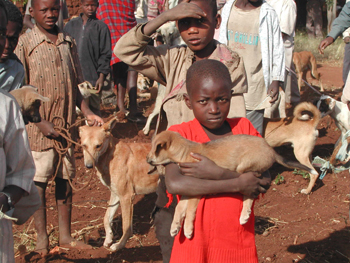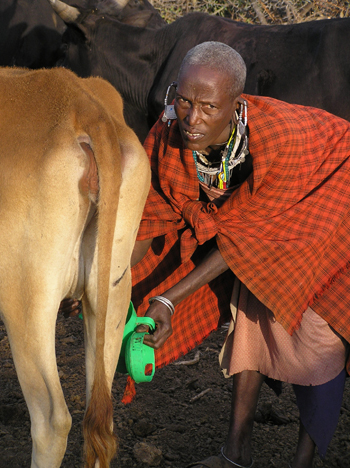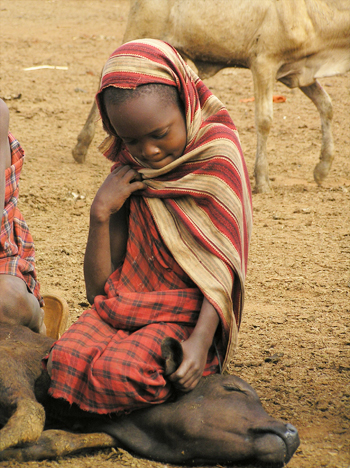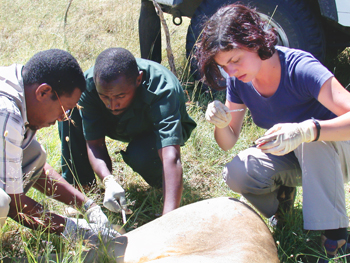Dr Tiziana Lembo
 Contact details
Contact details
Institute of Biodiversity, Animal Health and Comparative Medicine
University of Glasgow
Glasgow
Tel: +44 (0)141 330 6638
Email: Tiziana.Lembo@glasgow.ac.uk
Research interests
I am a field veterinary scientist with an interest in applied infectious disease epidemiology in complex multi-host environments. I focus primarily on pathogens affecting the health and livelihoods of marginalised communities in low- and middle-income countries, as well as diseases of conservation concern.
My research draws on a wide range of disciplines, and conventional and contemporary analytical tools to:
- Understand disease dynamics so to design effective strategies to reduce the burden of disease on human and animal populations;
- Investigate social, cultural and economic processes influencing community practices towards disease prevention;
- Provide evidence on the socio-economic consequences of disease leading to increased attention and action towards their research and prevention.
- Deploy simplified technologies to improve disease reporting and detection, and therefore the quality of data which can be generated from remote locations.
I have worked on a range of diseases, such as rabies, foot-and-mouth disease, anthrax, and canine distemper, with a focus on sub-Saharan Africa.
Rabies
 My research on rabies has contributed to developing the scientific body of evidence regarding the epidemiological, economic and operational feasibility of eliminating canine rabies through large-scale domestic dog vaccination. Yet, rabies continues to be an important cause of human mortality in many parts of the world: in Africa alone more than 25,000 people die from rabies each year.
My research on rabies has contributed to developing the scientific body of evidence regarding the epidemiological, economic and operational feasibility of eliminating canine rabies through large-scale domestic dog vaccination. Yet, rabies continues to be an important cause of human mortality in many parts of the world: in Africa alone more than 25,000 people die from rabies each year.
Knowledge and practices related to rabies prevention in affected communities are influenced by socio-economic status and level of education, with the greatest risk of developing rabies falling on poor members of the community with little or no formal education. In addition children are a primary risk group, but uncertainties remain about the most effective interventions (for example community- or school-based) to protect them from rabies, and the dynamics in the community and parent-child relationships that influence children’s practices.
Our current research aims at understanding social, cultural and economic processes which shape villagers’ and children’s engagement and participation in rabies prevention focusing on rural Tanzanian communities. This research will inform the design of awareness raising interventions targeting affected communities and specific sectors of the population (children, parents/ child carers, teachers).
We are also interested in understanding rabies persistence in endemic settings and establishing workable surveillance criteria and response strategies required to achieve and maintain freedom from canine rabies.
Rabies - additional info
(collaborators, funding, selected publications)
Collaborators
University of Glasgow: Katie Hampson, Sunny Townsend, Dan Haydon, Sarah Cleaveland, Daniel Wight, Sayantan Ghosal, Jane Coutts, Jason Matthiopoulos, Rebecca Mancy, Karen Hotopp, Claire Harris, Roman Biek, Kirstyn Brunker, Kennedy Lushasi
Other main collaborators: Animal and Plant Health Agency, UK (Anthony Fooks, Denise Marston); University of Surrey, UK (Dan Horton); Global Alliance for Rabies Control; Partners for Rabies Prevention; World Health Organization (WHO)/Pan American Health Organization (PAHO); World Organisation for Animal Health (OIE); Food and Agriculture Organization (FAO); Ministry of Livestock and Fisheries Development, Tanzania; Ministry of Health and Social Welfare, Tanzania; Ifakara Health Institute, Tanzania (Lwitiko Sikana, Maganga Sambo, Zac Mtema, Joel Changalucha); Sokoine University of Agriculture, Tanzania (Rudovick Kazwala); National Institute for Medical Research, Tanzania (Safari Kinung’hi, Sayoki Mfinanga); Tanzania Wildlife Research Institute; Tanzania National Parks; Washington State University, USA (Felix Lankester, Jon Yoder, Guy Palmer); Lincoln Park Zoo, USA (Anna Czupryna); MSD Animal Health (David Sutton, Alasdair King).
Current funding
UBS Optimus Foundation, Wellcome Trust, Bill and Melinda Gates Foundation, MRC, Lord Kelvin-Adam Smith studentship (University of Glasgow), MSD Animal Health.
Selected publications
- Lankester, F. et al. (2014) Implementing Pasteur's vision for rabies elimination. Science, 345 (6204). pp. 1562-1564. ISSN 0036-8075 (doi:10.1126/science.1256306)
- Sambo, M. et al. (2014) Knowledge, Attitudes and Practices (KAP) about rabies prevention and control: A community survey in Tanzania. PLoS Neglected Tropical Diseases, 8 (12). e3310. ISSN 1935-2727 (doi:10.1371/journal.pntd.0003310)
- Townsend, S. et al. (2013) Surveillance guidelines for disease elimination: a case study of canine rabies. Comparative Immunology, Microbiology and Infectious Diseases, 36 (3). pp. 249-261. ISSN 0147-9571 (doi:10.1016/j.cimid.2012.10.008)
- Lembo, T., and the Partners for Rabies Prevention (2012) The blueprint for rabies prevention and control: a novel operational toolkit for rabies elimination. PLoS Neglected Tropical Diseases, 6 (2). e1388. (doi:10.1371/journal.pntd.0001388)
- Lembo, T. et al. (2010) The feasibility of canine rabies elimination in Africa: dispelling doubts with data. PLoS Neglected Tropical Diseases, 4 (2). e626. ISSN 1935-2727 (doi:10.1371/journal.pntd.0000626)
- Lembo, T. et al. (2008) Exploring reservoir dynamics: a case study of rabies in the Serengeti ecosystem. Journal of Applied Ecology, 45 (4). pp. 1246-1257. ISSN 0021-8901 (doi:10.1111/j.1365-2664.2008.01468.x)
- Lembo, T. et al. (2007) Molecular epidemiology identifies only a single rabies virus variant circulating in complex carnivore communities of the Serengeti. Proceedings of the Royal Society of London Series B: Biological Sciences, 274 . pp. 2123-2130. ISSN 0962-8452 (doi:10.1098/rspb.2007.0664)
- Lembo, T. et al. (2006) Evaluation of a direct, rapid immunohistochemical test for rabies diagnosis. Emerging Infectious Diseases, 12 (2). pp. 310-313. ISSN 1080-6040 (doi:10.3201/eid1202.050812)
Impacts and coverage
- The Blueprint for Rabies Prevention and Control - http://www.rabiesblueprint.com/
- Article in the New York Times - 'Rabies: United Nations adds a new web site to its arsenal in fight against rabies'
- Article in the Lancet Infectious Diseases - 'Global rabies elimination: are we stepping up to the challenge?'
- Article in the Veterinary Record - 'Eliminating rabies at its source'
Foot-and-Mouth disease
 Foot-and-mouth disease (FMD) is one of the most important diseases affecting livestock production and trading globally, but its study and control in traditional livestock-keeping systems in sub-Saharan Africa has received little attention.
Foot-and-mouth disease (FMD) is one of the most important diseases affecting livestock production and trading globally, but its study and control in traditional livestock-keeping systems in sub-Saharan Africa has received little attention.
We study the disease in livestock-wildlife interface areas of north-western Tanzania to contribute data towards global FMD control frameworks (the FAO/OIE Progressive Control Pathway). We are interested in collecting the evidence demonstrating that FMD has considerable impacts on rural livelihoods, for example limiting milk production and sales, and traction capacity. We also aim to determine FMD risk factors in rural Tanzania settings, i.e. if these are livestock- or wildlife-related.
This will inform the design of strategies to control the disease in interface areas where susceptible livestock and wildlife (for example the African buffalo) co-exist. Another key area of research relates to the spatio-temporal distribution of FMD virus types (serotypes) and subtypes, and predictability of epidemics of specific serotypes needed to inform vaccine selection and delivery strategies.
Finally, we aim to strengthen surveillance capacity for FMD in remote locations using simple field-based diagnostic technologies and engaging directly with affected communities. This will lead to increased community-level motivation, responsibility, and involvement in decision-making for FMD reporting and control.
FMD - additional info
(collaborators, funding, selected publications)
Collaborators
University of Glasgow: Richard Reeve, Sarah Cleaveland, Dan Haydon, Miriam Casey, Richard Orton, Emma Howson
Other main collaborators: The Pirbright Institute (Satya Parida, Don King, Veronica Fowler, Valerie Mioulet, Nick Knowles, Kasia Bankowska); Ministry of Livestock and Fisheries Development, Tanzania; Sokoine University of Agriculture, Tanzania (Rudovick Kazwala, Tito Kibona, Ahmed Lugelo, Raphael Mahemba, Chris Kasanga, Gloria Ndhlovu); Tanzania Wildlife Research Institute (Robert Fyumagwa); Tanzania National Parks; University of Edinburgh, UK (Brian Perry, Mark Bronsvoort); TADP, ARC-OVI, Onderstepoort, South Africa (Francois Maree); Washington State University, USA (Tom Marsh, Jon Yoder, Deo Mshanga); MSD Animal Health (Alasdair King)
Current funding
BBSRC, MSD Animal Health, Wellcome Trust, Bill and Melinda Gates Foundation
Selected publications
- Casey, M.B. et al. (2013) Patterns of foot-and-mouth disease virus distribution in Africa. In: Johnson, N. (ed.) The Role of Animals in Emerging Viral Diseases. Academic Press, pp. 21-38. ISBN 9780124051911
- Ferguson, K.J. et al. (2013) Evaluating the potential for the environmentally sustainable control of foot and mouth disease in Sub-Saharan Africa. EcoHealth, 10 (3). pp. 314-322. ISSN 1612-9202 (doi:10.1007/s10393-013-0850-6)
Coverage
- BBSRC Impact Evidence Report: "Government and communities in Tanzania benefit from foot-and-mouth disease research", February 2016
- Article in the Horizons magazine (University of Glasgow) - 'The disease detectives' [PDF of magazine]
Anthrax
 In Africa, anthrax affects humans, livestock and wildlife, with consequences for human health, household income, and wildlife conservation. However, under-reporting and under-/mis-diagnosis of cases has led to a limited appreciation of the scale of the disease problem.
In Africa, anthrax affects humans, livestock and wildlife, with consequences for human health, household income, and wildlife conservation. However, under-reporting and under-/mis-diagnosis of cases has led to a limited appreciation of the scale of the disease problem.
The reasons for these data inadequacies include the fact that people do not report to hospitals; limited physicians’ awareness; and a lack of surveillance and diagnostic expertise and infrastructure locally. We aim to address these issues through improved surveillance involving grassroots-level information networks, field-friendly diagnostics, indicator species (for example domestic dogs) for identifying high-risk areas, and the development of molecular-based assays suitable for laboratories with limited diagnostic capacity.
We plan to use the improved disease incidence data obtained using these approaches to accurately quantify anthrax impacts on affected communities. We will also take advantage of the increasing availability and affordability of powerful tools for molecular characterisation and high throughput sequencing to study epidemiological links between animal and human anthrax, and therefore identify sources of human infection.
Anthrax - additional info
(collaborators, funding, selected publications)
Collaborators
University of Glasgow: Roman Biek, Ruth Zadoks, Richard Reeve, Katie Hampson, Sarah Cleaveland
Other main collaborators: Nelson Mandela African Institution of Science and Technology, Tanzania; National Institute for Medical Research, Tanzania (Safari Kinung’hi, Sayoki Mfinanga); Ministry of Livestock and Fisheries Development, Tanzania; Ministry of Health and Social Welfare, Tanzania; Tanzania Wildlife Research Institute; Tanzania National Parks; University of Calgary, Canada (Taya Forde); Public Health England, UK (Tim Brooks, Jackie Duggan); Washington State University, USA (Tom Marsh, Jon Yoder)
Current funding
NSERC (Natural Sciences and Engineering Research Council of Canada); European Commission
Selected publications
- Lembo, T. et al. (2011) Serologic surveillance of anthrax in the Serengeti Ecosystem, Tanzania, 1996–2009. Emerging Infectious Diseases, 17 (3). pp. 387-394. ISSN 1080-6040 (doi:10.3201/eid1703.101290)
- Hampson, K. et al. (2011) Predictability of anthrax infection in the Serengeti, Tanzania. Journal of Applied Ecology, 48 (6). pp. 1333-1344. ISSN 0021-8901 (doi:10.1111/j.1365-2664.2011.02030.x)
Coverage
Article in the Lancet Infectious Diseases - '' [PDF]
Canine distemper
 Canine Distemper Virus (CDV) is recognised as an important threat to the viability of endangered wildlife. We have been studying CDV in the Serengeti ecosystem since an epidemic in 1994 killed approximately 30% of lions (~1,000 individuals). Our interests are understanding the long-term mechanisms of maintenance of CDV in species-rich areas, where domestic dogs, typically associated with this pathogen, and a range of other susceptible carnivores co-exist.
Canine Distemper Virus (CDV) is recognised as an important threat to the viability of endangered wildlife. We have been studying CDV in the Serengeti ecosystem since an epidemic in 1994 killed approximately 30% of lions (~1,000 individuals). Our interests are understanding the long-term mechanisms of maintenance of CDV in species-rich areas, where domestic dogs, typically associated with this pathogen, and a range of other susceptible carnivores co-exist.
We have been using a range of approaches to address this question, including serological investigations of dogs and lions, modelling approaches, and intervention studies involving large-scale vaccination of dogs adjacent to the Serengeti National Park. Our results so far highlight complex maintenance and transmission processes involving a broad carnivore community comprising unvaccinated dogs and wild carnivores.
Because of these disease dynamics, dog vaccination alone may not be sufficient to eliminate infection and other options, which we are investigating, may need considering.
Canine distemper - additional info
(collaborators, funding, selected publications)
Collaborators
University of Glasgow: Mafalda Viana, Sarah Cleaveland, Jason Matthiopoulos, Jo Halliday, Katie Hampson, Dan Haydon, Brian Willett, Martin Gilbert.
Other main collaborators: University of Minnesota (Craig Packer, Meggan Craft), USA; Lincoln Park Zoo, USA (Anna Czupryna); Princeton University, USA (Andy Dobson); Cornell University, USA (Ed Dubovi); Tanzania Wildlife Research Institute (Eblate Ernest, Robert Fyumagwa); Tanzania National Parks; Washington State University, USA (Felix Lankester); MSD Animal Health (David Sutton); Wildlife Conservation Society, USA (Steve Osofsky).
Current funding
Lincoln Park Zoo, Washington State University, MSD Animal Health, Wellcome Trust, Royal Society (Newton International Fellowship).
Selected publications
Viana, M. et al. (2015) Dynamics of a morbillivirus at the domestic-wildlife interface: Canine distemper virus in domestic dogs and lions. Proceedings of the National Academy of Sciences of the United States of America . ISSN 0027-8424 (doi:10.1073/pnas.1411623112) (Early Online Publication)
Coverage
- University of Glasgow - 'Study sheds light on links between diseases of dogs and big cats'
- Washington State University - 'Dog disease in lions spread by multiple species'
- The Verge - 'How domesticated dogs made Serengeti lions sick, and what that means for other wildlife'
- The Naked Scientists podcast - 'Human impacts on ecosystems'
Additional information
Academic history
Positions held:
- Present: Post-doctoral research associate, College of Medical, Veterinary and Life Sciences, University of Glasgow.
- 2010 – 2014: BBSRC post-doctoral research associate (Combating Infectious Diseases of Livestock for International Development, CIDLID, programme), College of Medical, Veterinary and Life Sciences, University of Glasgow.
- 2009 – 2010: Scientific and technical advisor for the Bill & Melinda Gates Foundation (BMGF) grant to the Department of Neglected Tropical Diseases, WHO, and Global Alliance for Rabies Control (GARC) - “Canine rabies elimination demonstration project in Tanzania”. Programme Officer for GARC.
- 2008 - 2009: Scientific and veterinary advisor for the Serengeti Ecosystem Health Project, Conservation and Science Department, Lincoln Park Zoo/ Wellcome Trust ‘Value in People’ (VIP) Fellow, School of Veterinary Medicine, University of Glasgow.
- 2007 - 2008: BBSRC Wain Fellow (University of Glasgow), hosted by Sokoine University of Agriculture, Morogoro, Tanzania
Academic record:
- 2007: PhD, University of Edinburgh, Centre for Tropical Veterinary Medicine: “An investigation of disease reservoirs in complex ecosystems: rabies and canine distemper in the Serengeti”.
- 2002: MSc in International Animal Health, University of Edinburgh, Centre for Tropical Veterinary Medicine. MSc dissertation: “Investigation of the role of Ixodes ticks as potential vectors of Ehrlichia Ondiri, the agent of Bovine Petechial Fever”.
- 2000: Degree in Veterinary Medicine (DVM), University of Milan, Faculty of Veterinary Medicine. Undergraduate thesis: “Epidemiological patterns of Canine Leishmaniasis in Western Liguria and evaluation of risk factors”.
Awards & Fellowships
Grants awarded:
As Principal Investigator
- 2008 – 2009: Wellcome Trust VIP Award.
- 2008 – 2009: Davee Center for Epidemiology and Endocrinology, Lincoln Park Zoo.
- 2007 - 2008: Wain International Travel Fellowship, BBSRC.
- 2005: Small Project Grant, The University of Edinburgh Development Trust.
- 2002: School of Veterinary Studies Postgraduate Scholarship, University of Edinburgh.
- 2002: Birrel-Gray Travelling Scholarship, University of Edinburgh.
As Co-investigator
- 2015 – 2017: European Commission Marie Skłodowska-Curie Individual Fellowship to Taya Forde, Molecular epidemiology of Bacillus anthracis: novel data and techniques for local surveillance in Tanzania.
- 2014 – 2018: Lord Kelvin & Adam Smith scholarship, University of Glasgow, The allocation of attention and mitigation of disease transmission: theory and evidence from Tanzania.
- 2014 – 2016: Wellcome Trust Master’s Training Fellowship in Public Health and Tropical Medicine for Kennedy Lushasi, Rabies persistence and elimination from the island of Pemba, Tanzania.
- 2013 – 2017: BBSRC partnership award, Assessing the impact of foot-and-mouth disease control programmes.
- 2011 - 2015: UBS Optimus Foundation, Building public health models: rabies prevention - Global Alliance for Rabies Control as lead organization.
- 2007 – present: Lincoln Park Zoo/Washington State University, Serengeti Ecosystem Health project.
- 2009 - 2013: Bill and Melinda Gates Foundation, Canine rabies elimination demonstration project in Tanzania – WHO as lead organization.
- 2009 - 2010: Google Foundation, Establishing methodologies for surveillance of zoonotic and emerging diseases in Tanzania: a pilot program in the Serengeti Ecosystem – Sokoine University of Agriculture, Tanzania, as lead institute.
- 2009 – 2011: UBS Optimus Foundation, Road-testing innovative surveillance technologies for rabies project – Ifakara Health Institute, Tanzania, as lead institute.
- 2010 – 2013: Medical Research Council, Understanding how a complex intervention works: Designing large-scale vaccination programmes.
Dr Tiziana Lembo
- Senior Lecturer (Infectious Disease Ecology)
telephone:
01413303940
email:
Tiziana.Lembo@glasgow.ac.uk
pronouns:
She/her/hers
Room 5106, Advanced Research Centre, 11 Chapel Lane, University of Glasgow, Glasgow, G12 6EW
Research interests
Find out more about my work: Research interests
I am a field veterinary scientist with an interest in applied infectious disease epidemiology in complex multi-host environments. I focus primarily on pathogens affecting the health and livelihoods of marginalised communities in low- and middle-income countries, as well as diseases of conservation concern.
My research draws on a wide range of disciplines, and conventional and contemporary analytical tools to:
- Understand disease dynamics so to design effective strategies to reduce the burden of disease on human and animal populations;
- Investigate social, cultural and economic processes influencing community practices towards disease prevention;
- Provide evidence on the socio-economic consequences of disease leading to increased attention and action towards their research and prevention.
- Deploy simplified technologies to improve disease reporting and detection, and therefore the quality of data which can be generated from remote locations.
I have worked on a range of diseases, such as rabies, foot-and-mouth disease, anthrax, and canine distemper, with a focus on sub-Saharan Africa.
Grants
Grants and Awards listed are those received whilst working with the University of Glasgow.
- A One Health framework for assessing the risks of antimicrobial resistance within the aquatic environment in north-eastern Thailand to inform mitigation strategies
UK Research and Innovation
2025 - 2028
- Making the Invisible Visible: Antimicrobial Stewardship in Tanzania
British Academy
2024 - 2025
- Sustaining and securing futures for antimicrobial resistance research in East Africa
Scottish Funding Council
2023 - 2024
- Empowering engagement for antimicrobial resistance policy change in Tanzania
Medical Research Council
2022 - 2023
- Empowering engagement for antimicrobial resistance policy change in Tanzania
Engineering and Physical Sciences Research Council
2022 - 2023
- SAREE
European Commission
2018 - 2021
- Supporting the National Action Plan for Antimicrobial Resistance (SNAP-AMR) in Tanzania
Medical Research Council
2018 - 2021
- SFC-GCRF: Moving towards integration of syndromic and laboratory surveillance of zoonoses in Tanzania
Scottish Funding Council
2017 - 2017
- Atypical bovine morbillivirus infections in the Serengeti ecosystem
Biotechnology and Biological Sciences Research Council
2017 - 2020
- BBSRC GCRF Fund Impact Accelerator Extension - Boyd Orr
Biotechnology and Biological Sciences Research Council
2017 - 2018
- Supporting the National Action Plan on AMR in Tanzania (SNAP-AMR)
Medical Research Council
2017 - 2018
- Understanding cultural, social and epidemiological drivers of human anthrax infection in rural African communities
Wellcome Trust
2017 - 2019
- Understanding cultural, social, and epidemiological drivers of human anthrax infection in rural African communities
Academy of Medical Sciences
2017 - 2019
- Identifying anthrax hotspots and the associated ecological factors in Kenya
Defense Threat Reduction Agency
2017 - 2020
- Identifying anthrax hotspots and the associated ecological factors in Kenya
US Department of Defense
2017 - 2020
- BBSRC IAAF - Boyd Orr Tanzania Research Accelerator
Biotechnology and Biological Sciences Research Council
2016 - 2017
- African Science Partnership for Intervention Research Excellence (Afrique One-ASPIRE)
Wellcome Trust
2016 - 2021
- Molecular epidemiology of Bacillus anthracis: novel data and techniques for local surveillance in Tanzania
European Commission
2015 - 2017
- Enhancing the Health and Productivity of Livestock (PEHPL)
Bill and Melinda Gates Foundation
2015 - 2018
- African Research Consortium for Ecosystem and Population Health: "Expanding Frontiers in Health
Wellcome Trust
2014 - 2016
- Assessing the impact of foot-and-mouth disease vaccination programmes
Biotechnology and Biological Sciences Research Council
2013 - 2017
- Communities Against Rabies Exposure (CARE)
UBS Optimus Foundation
2011 - 2016




